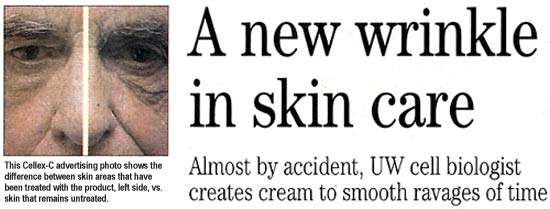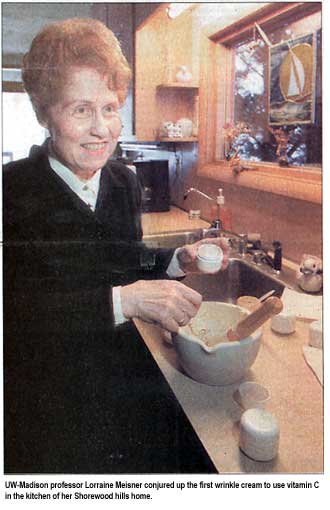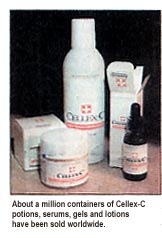
 
Lorraine Meisner is an eminent cell biologist at UW-Madison who has devoted much of her career to unlocking the genetic mysteries of breast cancer and malignant melanoma.
So it’s not without irony that a wrinkle cream she invented on a whim, in the kitchen of her Shorewood Hills home, is bringing her international fame and fortune.
About a million bottles of the wrinkle creams and serums Meisner developed have been sold worldwide, even though her cream, Cellex-C, costs between $42 and $195 per container.
In Australia  —which is affected by a large hole in the ozone layer, leaving the skin of its largely pale, freckled population of Celtic descent ravaged by the sun — it is the No. 1-selling skin treatment. —which is affected by a large hole in the ozone layer, leaving the skin of its largely pale, freckled population of Celtic descent ravaged by the sun — it is the No. 1-selling skin treatment.
Dermatologists and plastic surgeons are selling it to their clients because it cuts healing time in half after laser and chemical face peels.
Elle magazine called Cellex-C “the underground favorite of socialites and celebrities.”
“I was really embarrassed at first because it seemed so frivolous,” Meisner said. “I didn’t tell anybody that I’d made this wrinkle cream for three or four years. I didn’t even wear cosmetics because I don’t think people should put a lot of gunk on their faces.
“But it’s OK now; my colleagues still think of me as a serious scientist.”
Meisner’s focus on skin care began in 1986, when she learned that many older women had started using Retin A — the same product used by teens to fight acne — on their skin to combat wrinkles.
“I was appalled, “ Meisner said. “It’s a chemotherapy agent that causes cell hyperproliferation.
It causes resting cells to divide....We shouldn’t push our luck by encouraging constant cell proliferation.
“You can’t do that indefinitely because some skin cells die after 45 or 50 divisions. Retin A is OK for teen-agers because it’s only used for a short time.” 
Continued from above
Another ominous side effect of Retin A observed by Meisner was that it
made skin highly sensitive to the sun — so while the skin might look
better initially, it actually would be more susceptible to damage.
“There were all these women putting Retin A on their faces and then going out to play golf,” she said. “I wanted to try a different approach. I wanted to stop people from doing something that was causing them harm.
“I did it as a joke, to prove it would work better than Retin A.”
Meisner also attacked the problem at a deeper layer of the skin.”
“It seemed to me that all the skin products that were being tried were like trying to pull a sheet tight over a lumpy mattress. I thought, instead, you should pouf up the mattress itself.”
Meisner, a professor of cytogenetics and preventive medicine, was the first to explore the topical application of vitamin C. At the time, it was a revolutionary idea. Although vitamin C was isolated in 1928, people had only recently accepted the notion that taking high doses of vitamin C might have overall health benefits.
In 1986, Meisner may have been the only one who thought putting it on your skin accomplished anything.
As late as the 1950s, some dermatologists believed the skin was little more than a waterproof shield. But skin, in fact, is a multi-dimensional terrain, with pores that absorb some chemicals as effectively as a sponge.
It is only in the past half century that some drugs have been delivered topically. Among the best known are nicotine and estrogen patches.
To Meisner, treating the skin directly seemed the logical way to get to the root of wrinkles.
The process of the human face falling from rosy tautness to a labyrinth of lines is a complicated one. Scientists now understand that it has very little to do with the passage of time. Sun, smoking, stress, pollution and even normal eating and drinking are the enemies.
They all contribute to the breakdown of collagen by producing an onslaught of what are known as free radicals. Free radicals destroy vitamin C, without which the body can’t maintain its collagen, the substance that keeps human tissue firm. When collagen breaks down the skin sags and wrinkles.
It seemed to Meisner that taking a vitamin C supplement by mouth, and hoping the nutrients would reach the skin, was a hit-or-miss proposition. She envisioned a more direct approach.
“The problem with vitamin C is that it is very unstable,” Meisner said. “That’s why no one thought it would do any good to put it directly on the skin.”
The trick, then, was to product it in a form that would allow the skin to make use of vitamin C before it passed through the body. Keeping the skin supplied with other antioxidant vitamins, A and E, is not a problem because they are fat soluble and stay in the body. Vitamin C, in contrast,needs to be replenished frequently.
Although Meisner works in laboratories with state-of-the-art computers, she concocted Cellex C with a mortar and pestle, like a medieval alchemist.
She settled on a mixture of 10 percent ascorbic acid (a pure form of vitamin C) with the mineral zinc and the amino acid tyrosine.
“You need all three for it to work. You can’t just rub an orange in your arm.”
Meisner tried the solution on friends, family and herself, with striking skin changes. Now, the question was what to do with her fountain-of-youth skin formula.
Because it was a cosmetic, or in the new category of “cosmaseuticals”, Meisner wasn’t able to attract grant money to develop the product. The Wisconsin Alumni Research Foundation (WARF), the patent arm of UW-Madison wasn’t interested in it either, for the same reason.
Finally, after articles about Meisner’s discovery appeared in the New York Times and Longevity magazine, a small Canadian company that sells anti-aging products bought right to produce it. With Madison physician Michael Schinitsky as her partner, Meisner conducted clinical trials and double-blind tests, and got a patent in 1990.
Their first product in 1991 was a “skin food” cream with fresh strawberries that was sold mostly through mail orders.
“The problem was that by the time it was shipped to South, the strawberries were rotten,” she said.
But after that early snafu, Cellex-C began to ignite. With virtually no advertising, word-of-mouth made it a hot seller.
It is usually bought through professional aestheticians, dermatologists and plastic surgeons, though a prescription is not required.
“WARF says turning down the patent was the one mistake they’ve made,” Meisner said.
Success brought a rash of imitators, however. There are at least 100 patent infringement suits under way. “That wouldn’t have happened if WARF held the patent.” Meisner said. “Nobody messes with WARF.”
Worse yet, she said, many skin products that claim to contain vitamin C either have minuscule amounts or forms of the vitamin that can’t be used by the skin, so people are wasting their money.
Meisner said she doesn’t control pricing of Cellex-C, and isn’t happy about its cost.
She hopes that eventually it can be mass-produced in squirt bottles so children can enjoy the sun without having to pay a heavy price decades later, not just in wrinkled, splotchy skin, but in skin cancer.
Reproduced with permission.
|
|
|
|